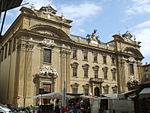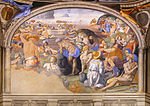San Remigio, Florence
1000s establishments in Europe11th-century Roman Catholic church buildings in Italy11th-century establishments in Italy13th-century Roman Catholic church buildings in ItalyItalian church stubs ... and 1 more
Roman Catholic churches in Florence

San Remigio di Firenze is a church in Florence, Italy. The church was founded around the year 1000. It is dedicated to Saint Remigius. In the 13th century, the church was reconstructed to feature a triangle-shaped facade with hanging arches along the roof line. The interior still reflects the original Gothic architecture with ogive arches and octagonal columns along the three aisles.
Excerpt from the Wikipedia article San Remigio, Florence (License: CC BY-SA 3.0, Authors, Images).San Remigio, Florence
Kuckucksleegde,
Geographical coordinates (GPS) Address Nearby Places Show on map
Geographical coordinates (GPS)
| Latitude | Longitude |
|---|---|
| N 43.768448 ° | E 11.258009 ° |
Address
Kuckucksleegde 2 a
26629 , Wrisse
Niedersachsen, Deutschland
Open on Google Maps











